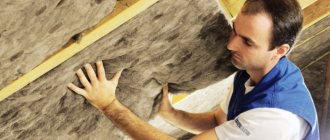Subtleties of roof insulation with expanded clay
What is the best way to arrange a home to make it cozy and warm? The building loses up to 20% of its heat through the roof. Therefore, when deciding on the insulation of a building, it is necessary to decide how and with what to insulate the roof.
Roof insulation with expanded clay is one of the oldest methods, but it is still quite often used for thermal protection of buildings. Expanded clay is recognized as a universal insulation material. Its popularity is due to its low price and high performance characteristics.
Expanded clay bend
The slope of expanded clay roofing is carried out to protect the roof from the aggressive action of external factors. How to make a ramp from expanded clay, calculate the material and prevent possible difficulties in the work.
Expanded clay slopers are widely used in the installation of drainage systems on roofs with flat roofs. The material is well suited for this job because it is low cost, durable and has high performance characteristics. Before we learn in detail about how deflection is performed and what nuances need to be taken into account, we will learn about the definition of “reversal”.
The slope of the roof is carried out to protect the roof from the aggressive action of external factors. How to make a ramp from expanded clay, calculate the material and prevent possible difficulties in the work.
Material properties
Since expanded clay is a material that has a natural base, it has strength and durability that synthetic materials do not have. Its service life is an order of magnitude higher than wood insulation. Another advantage is that rodents do not grow in its layer.
The raw material for making expanded clay is clay, so it is not afraid of rotting. Its structure cannot be changed by low temperatures in severe frosts or high temperatures in hot weather. It is not destroyed by moisture.
Expanded clay is produced by melting and firing clay. To do this, only certain varieties are selected, pre-dried and crushed.
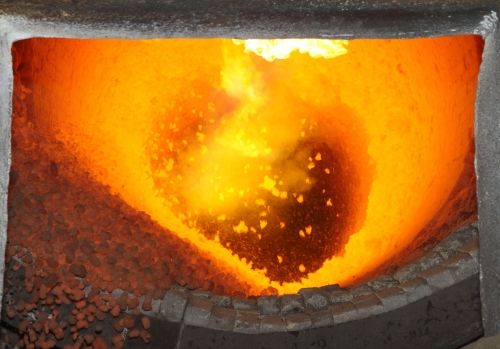
Raw materials are loaded into a drum-type oven, which rotates at a certain speed. Heated air is supplied to the oven. As it moves down the drum, the clay begins to stick together into lumps, sinter, and rotation gives it a rounded shape.
The quality of expanded clay and the size of its granules are achieved by regulating the temperature of the heated air and the rotation speed of the furnace. As a result, the output is an environmentally friendly material with excellent thermal insulation, soundproofing, fireproof and frost-resistant characteristics.
Several types of expanded clay can be used as insulation - crushed stone, gravel, sand.

But crushed stone has sharp edges, and sand is heavy. Therefore, gravel is more suitable for roof insulation. It allows you to fill all cavities and create a high-quality thermal insulation layer. For the best effect, expanded clay gravel is mixed with foam chips. It is possible to use expanded clay of several fractions at once.
A layer of 10 cm of insulation is comparable to 25 cm of wooden beams, 60 cm of expanded clay concrete slab, and a meter of brickwork. But it is better if the layer exceeds 15 cm, then the maximum effect is obtained. In addition, such insulation is 3 times more economical than wood, and 10 times more economical than a brick wall.
Technology
Expanded clay insulation is a process that does not require special knowledge and can therefore be done independently. The main thing is to take into account the design features of the building, walls, roof slope and know the correct sequence of work.
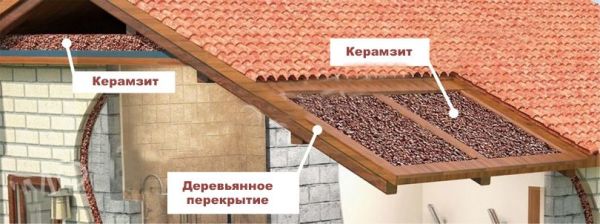
Traditional roof thermal insulation technologies require a certain procedure: first, the internal lining is done, then a vapor barrier is applied, a layer of insulation is laid down, waterproofing is applied, and the entire roof covering is completed. When using expanded clay, the essence of the process is the same.
Thermal insulation of the ceiling in a wooden house
When insulating wooden structures, it is important to protect the surface from moisture. To do this, a vapor barrier is installed. Foil, foil-coated isolon, roofing felt or polyethylene film are suitable as a vapor barrier material.
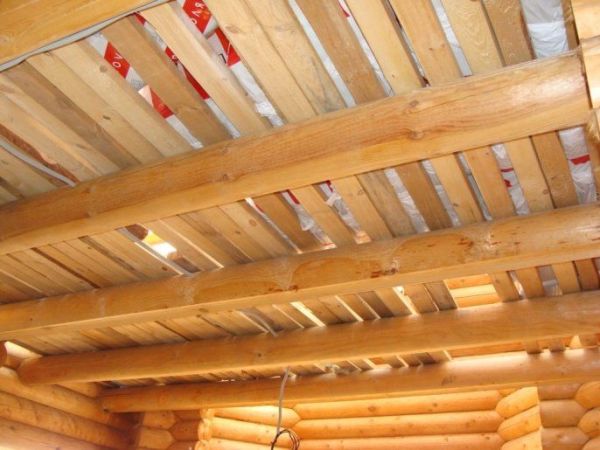
The metalized side of the vapor barrier should be directed into the living space. The material must be laid with an overlap, with an overlap of approximately 10–15 cm on the wall. To exclude the possibility of moisture penetration, all seams and joints must be taped.
If a foil vapor barrier is used, then metallized tape is used to process the joints, the film can be glued with ordinary tape, and rubber-bitumen mastic is used for roofing felt.
The vapor barrier must cover the floor beams.
Then a layer of expanded clay is poured and leveled. Sometimes experts advise laying a small layer of soft clay on the vapor barrier before backfilling for additional heat and sound insulation. The recommended thickness of the expanded clay layer is 14–16 cm.
It is important to leave a gap between the insulation and the future floor so that during operation there is no squeaking from the friction of expanded clay granules against each other.
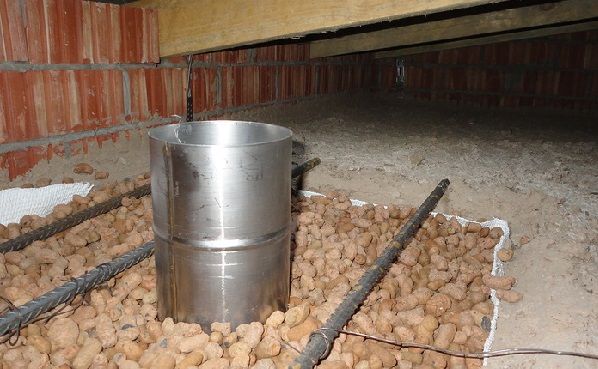
The filling of the material must be done very carefully so that the granules are not damaged. Otherwise, the thermal insulation characteristics of the insulating layer will decrease.
Expanded clay absorbs moisture well, which is why it becomes very heavy. Therefore, a second layer of moisture-repellent coating is laid on top of the insulation or a cement-sand screed is made.
The final stage of work is installation of the floor covering.
When filling a wooden ceiling with expanded clay, it is necessary to take into account the strength of the structure. The use of expanded clay to insulate a false ceiling in a wooden house is permissible only with a large margin of fastening strength. For example, if there is additional sheathing. Otherwise, the structure may not withstand the load.
Laying on a reinforced concrete base
If there are reinforced concrete slabs on the roof of the upper floor, the thermal insulation process is simplified. In this case, the bottom layer of vapor barrier is not needed. A layer of expanded clay gravel is poured onto the concrete slabs, compacted, and, if possible, a screed is made.
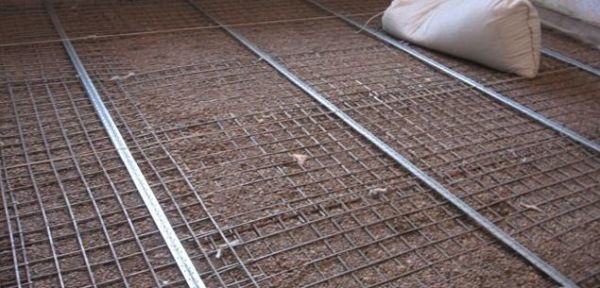
The screed provides the necessary rigidity and levels the surface for laying roofing felt roll carpet. It is important to provide ventilation ducts to remove excess moisture.
If desired, any waterproofing materials and paving slabs can be laid on top of the roofing felt, which increases the service life of roofing structures. In Germany, roofs are very common, covering them in a similar way, but instead of paving slabs they use a lawn carpet. They call such structures “green roofs.” In conclusion, I would like to remind you that high-quality roof insulation depends on the materials used, the correct calculation of supporting structures, the slope of the roof, and good waterproofing.
Insulation materials
To ensure that your home is always warm and cozy with the onset of winter, you need to take care of roof insulation in advance. Today, more and more people are choosing expanded clay as insulation. It is widely available and inexpensive, as well as environmentally friendly and has excellent performance characteristics.
What is expanded clay, its advantages and disadvantages
Expanded clay is a lightweight porous material in the form of small granules, obtained by firing clay. It has gained popularity both among professional builders and home craftsmen, thanks to the following technical indicators:
- high heat and noise insulation;
- frost-resistant qualities;
- fireproof qualities;
- strength, resistance to rotting;
- long service life, resistance to temperature changes.
Expanded clay, the price of which is much lower than the price of other thermal insulation materials, can last, unlike them, for many years. Its main advantages are:

- high thermal conductivity;
- light weight;
- not susceptible to chemically aggressive environments;
- does not emit toxic substances into the atmosphere;
- This is the only thermal insulation material that does not require special knowledge, skills and experience when working with it.
But this material also has its drawbacks, although they are few:
- to achieve a high level of heat and sound insulation, you need to lay out the material in a fairly thick layer;
- is not resistant to moisture, therefore, when insulating damp rooms, a special film for waterproofing should be used;
- the material is quite fragile, and damage to the granules leads to a decrease in the quality of thermal insulation.
Tools and materials required for roof insulation with expanded clay
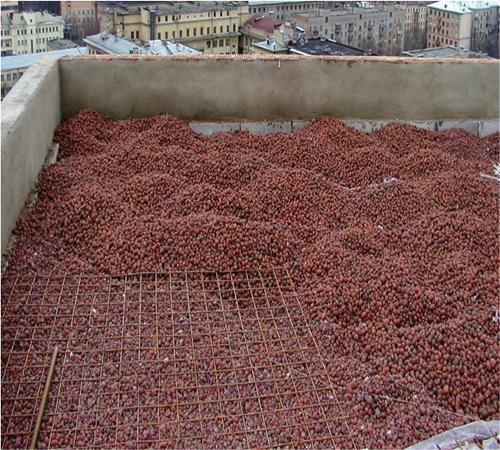
In order to insulate the roof yourself, you will need the following materials and equipment:
- expanded clay for the roof;
- shovel and buckets;
- a log or stick to compact the insulation layer, and a lath to level it;
- waterproofing film;
- roofing felt in rolls;
- sharp knife;
- tiles or tiles for external covering.
Steam and waterproofing for expanded clay
Steam and waterproofing of the insulating layer is an important stage in the construction of the roof, which in no case should be overlooked. As mentioned earlier, expanded clay is capable of absorbing moisture. At the same time, its thermal insulation qualities sharply deteriorate, and it itself becomes much heavier than in dry form. This can lead to dire consequences, including the collapse of the ceiling. Thus, if the expanded clay layer is allowed to become wet, the service life of the roof can be sharply reduced, and repairs will be required much earlier than planned.
Insulation of pitched roofs
Things are a little more complicated. The most important thing here is to achieve uniform filling of the insulation layer into the space between the rafters.
To prevent particles from rolling off, the space between the support beams is divided by horizontal bridges. As they are filled, the cells are covered with boards from the outside.
After the entire volume of the space between the rafters is filled, waterproofing and finishing roofing are carried out along the sheathing boards. The vapor barrier film is secured to the rough internal cladding on the room side. The sealing rules for insulating materials are similar here - overlapping panels and gluing joints.
As you can see, expanded clay, although not an entirely easy-to-work material, is quite versatile. Carrying out simple measures allows you to create ideal conditions for its operation and perform insulation of various roof structures.
What is the best way to arrange a home to make it cozy and warm? The building loses up to 20% of its heat through the roof. Therefore, when deciding on the insulation of a building, it is necessary to decide how and with what.
Roof insulation with expanded clay is one of the oldest methods, but it is still quite often used for thermal protection of buildings. Expanded clay is recognized as a universal insulation material. Its popularity is due to its low price and high performance characteristics.
How to insulate a roof with expanded clay: the main stages of work

Today, properly performed insulation work is of great importance for maintaining comfort and warmth in the house. Insulation of walls, foundation, floor, roof is an integral part of the work during construction. Roof insulation occupies a special place. They insulate it for several reasons. Firstly, a layer of thermal insulation material helps maintain an optimal microclimate, in particular temperature and humidity, in the house itself. Secondly, thermal insulation prevents condensation from forming inside the building. Condensation can contribute to the gradual destruction of the entire structure, its freezing, as well as the appearance of mold fungi and microorganisms, which can negatively affect the health of residents.
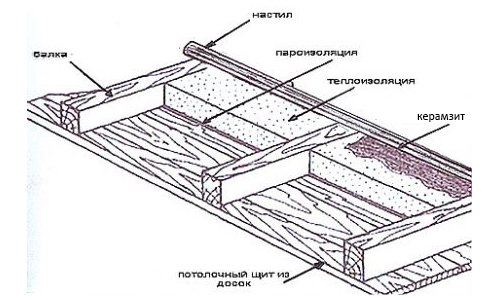
Scheme of attic floor insulation with expanded clay.
The roof is the first barrier between the outside air and the premises. The roof of the house protects from cold wind and precipitation. When performing insulation work, it is important to remember that, in addition to thermal insulation, you will definitely need to waterproof the roof to protect it from moisture. You can insulate the roof of a house with a variety of materials: expanded polystyrene, penofol, polystyrene foam, mineral wool, glass wool and expanded clay. The last option is one of the simplest and most common. Find out in more detail how roof insulation is carried out with expanded clay, insulation technology, advantages and disadvantages of this material.
Using expanded clay to insulate the roof of a house
Scheme of roof insulation with expanded clay.
You can organize roof insulation on your own; you don’t need to hire specialists for this. Before you insulate it, you need to know what expanded clay is and why it is so highly valued for thermal insulation of buildings and structures. Expanded clay is a natural material. It is highly durable and can last a long time, unlike synthetic insulation. It is based on clay. Due to all this, it does not rot and can withstand very low temperatures, which is especially valuable in cold climates. It has a crumbly and porous structure. Porosity helps retain heat. The big advantage of this material is its fire resistance.
Insulation is most often carried out with expanded clay gravel, sand or crushed stone. In addition to all of the above, expanded clay is a fairly lightweight material, which simplifies the work. Today, many synthetic materials are not environmentally friendly, which cannot be said about expanded clay. It is absolutely safe for humans to use. Expanded clay is waterproof, so there is no need to make an additional waterproofing layer. Its cost is low, which is of great importance in the consumer market. In addition, it puts minimal load on the entire house and the roof itself. The main disadvantage is its fragility.
Roof insulation technology with expanded clay
Scheme of single-layer attic insulation.
Before insulating the roof with expanded clay, you need to know some of the features of this work. First of all, to obtain a good effect, it is advisable to take into account the features of the house, its structure, walls, and roof slope when insulating the roof. Modern technology for insulating a roof (roof) includes several main stages: internal lining, vapor barrier, laying a layer of insulation and surface finishing work (laying slabs or other covering).
Expanded clay insulation is no different from the standard. If there is a reinforced concrete floor with slabs on the upper floor of the house, then the work is somewhat easier.
First of all, to insulate the roof (roof), you need to pour a layer of expanded clay gravel onto the slabs, you can use crushed stone or a mixture of both.
This will ensure a more complete and thorough filling of all voids and irregularities. The layer thickness should be 25 cm. Expanded clay gravel is leveled and compacted. This can be done manually or using a special machine. It is recommended to apply screed on top of the first layer. This will give the structure greater strength and rigidity, and a smoother surface. It is advisable to organize several ventilation channels between the inner and outer layers so that it is possible to remove excess moisture and ventilate the space. Roofing felt is placed on top of the insulation layer. It is important that the rolls overlap and there are no gaps. On top of it are tiles or tiles.
List of tools and equipment
Roof insulation will require a whole set of tools and materials. It includes: insulation (expanded clay gravel or crushed stone), shovel, buckets, log or stick for compaction, slats for leveling the expanded clay layer, waterproofing film, rolled material (roofing felt), knife, tiles or tiles. Based on all of the above, we can conclude that roof insulation using expanded clay is an effective and simple method. This material is fireproof, light, durable, resistant to low temperatures and moisture, which is especially important for our country. In addition to thermal insulation properties, it has a noise-proof effect due to its physical and chemical characteristics. It is durable, which is why it is so widely used. Expanded clay is used not only to insulate the roof (roof), it is perfect for insulating floors, hangars, that is, any horizontal structures.
Roof insulation with a layer of expanded clay
Roof insulation is most often performed using the following types of expanded clay:
- Expanded clay crushed stone. It is a large material. The size of its granules does not exceed 4 centimeters. Well suited not only for thermal insulation of the roof, but also for insulation of walls and floors in the house;
- Expanded clay gravel. This material is also coarse-grained. Its granules have an angular shape and do not exceed 4 centimeters in size;
- Expanded clay sand. It is a finely dispersed material. Particle size is up to 5 millimeters. When using this material as insulation, the layer thickness should not be more than 5 centimeters.
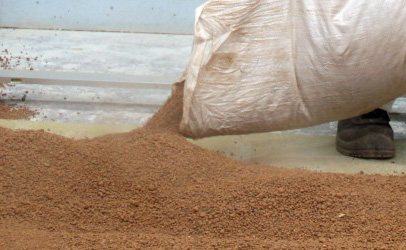
expanded clay sand
As mentioned above, it is quite possible to perform thermal insulation using expanded clay with your own hands.
Before you begin thermal insulation work, you need to study certain subtleties of the insulation process. First of all, you need to pay attention to the design features of the building.
Insulating the roof of a house with expanded clay includes the following steps:
- Internal lining;
- Laying a vapor barrier layer;
- Laying thermal insulation;
- Surface finishing.
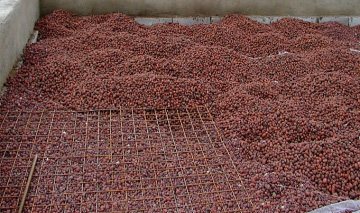
Detailed description of work:
- The thickness of the expanded clay layer when insulating the roof should be 25 centimeters. It should be poured directly onto the vapor barrier material. This work must be done quickly and very carefully so as not to damage the granules of the material.
- To improve noise and heat insulation, it is advisable to make the expanded clay layer thicker. However, you should remember the maximum load that the roof of the house can withstand. In this case, it is best to choose a middle ground.
- Next, you need to properly level and compact the expanded clay layer. Then there will be fewer voids between the particles of the material, and the thermal insulation will be better. Expanded clay must be compacted by hand or with a special machine. Next, it is recommended to screed over the first layer. Due to this, the structure will become stronger and more rigid, and the surface will be more even.
- It is also necessary to make several channels between the inner and outer layers. Moisture will be removed through these channels and air will also circulate.
- At the next stage, roofing felt is laid on top of the heat-insulating layer. It must be overlapped. To ensure that the roofing felt seams are airtight, they are insulated using bitumen mastic or construction tape.
- At the final stage, the installation of tiles or tiles is carried out.
The use of expanded clay for roofing
Roof insulation with expanded clay is the most popular method
For the first time, roofs began to be insulated using expanded clay more than half a century ago. Of course, the modern building materials market offers a wide range of insulation materials, but many continue to consider expanded clay insulation as one of the best for well-equipping a flat or pitched roof.
Important! It is expanded clay that will ensure the almost complete absence of problems that may arise regarding condensation, and will also eliminate such a problematic phenomenon called the “dew point”.
The roof is the most important element of any residential structure. For the interior space of a home, it is the primary protection. Both the comfort of living and cozy conditions in the house completely depend on how reliable it is. And expanded clay is a material that helps ensure such qualities for a long time.
Characteristics
Expanded clay is a very light porous material that is obtained by firing slate and clay.
Having a natural base, this building material has good strength and can last quite a long time, unlike synthetic materials. When the roof is insulated with expanded clay, there is no risk of rotting processes, as, for example, with wooden materials; the structure does not change under the influence of low temperatures in cold weather or elevated temperatures in hot weather. Water that gets into the insulation does not affect it in any way. Thus, expanded clay is recognized as a universal material for insulation.
Important! Based on its characteristics and properties, expanded clay is recognized as the best option for roof insulation. Indoors, this way you can achieve the greatest indoor comfort.
It should be noted that in pitched roofs there is very little space for thermal insulation. In this regard, flat roofs are much more convenient.
Advantages and disadvantages of roof insulation with expanded clay
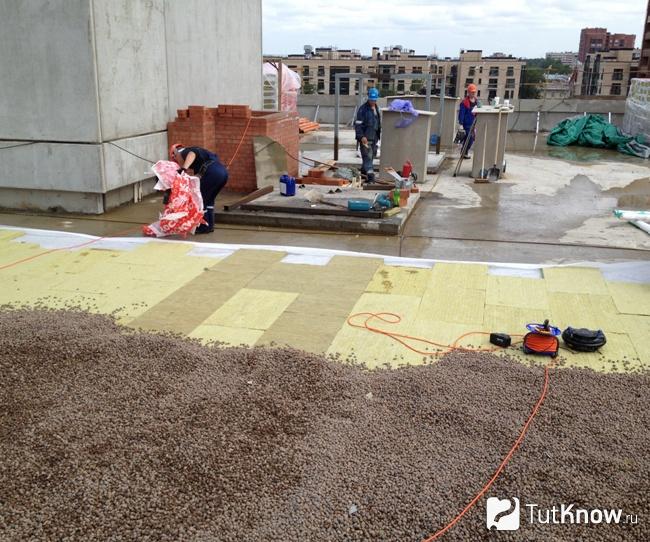
Since expanded clay is based on a natural base, it in many ways successfully competes with synthetic insulation materials. The structure of expanded clay cannot be disturbed by temperature changes, moisture, or rotting.
In addition, thermal insulation of the roof with this material has a number of other advantages:
- Bulk insulation does not require joining of elements and installation of fasteners.
A roof insulated with expanded clay does not emit fumes harmful to health into the space.
It is extremely inedible for living creatures.
Expanded clay, being a fire-resistant material, cannot become a source of fire on the roof.
A disadvantage of expanded clay insulation is the significant load the material places on the roof, despite the low weight of its porous granules. After all, the mass of a backfill layer with a thickness of 100-400 mm is very significant. Another disadvantage of insulation is its excessive absorption of moisture. Soaked material loses its quality. Therefore, when insulating a roof with expanded clay, a protective waterproof film should be laid on it.
How to insulate a roof using expanded clay
The initial stage of work will be similar to those performed when using any other material. The ceiling must be protected from the accumulation of condensation due to warm air escaping upward. You can use foil insulation, aluminum foil or vapor barrier film for this. It is absolutely easy to insulate a flat roof with expanded clay.
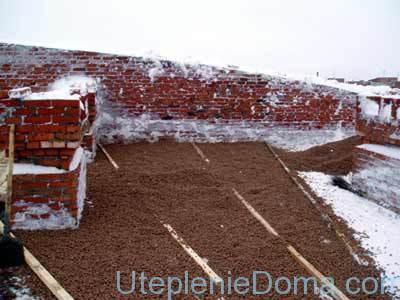
Insulation of a flat roof with expanded clay - a lightweight option for roof insulation
Expanded clay should not be poured directly onto the vapor barrier. First, the layer of material must be fixed, and then covered with a layer of soft clay. It itself is good enough to insulate from noise and has excellent thermal insulation properties. For this reason, it should act as the first layer for insulation, and the expanded clay filling should act as an intermediate layer.
When performing insulation for flat or pitched roofs, expanded clay gravel is mainly used. It is extremely convenient for filling recesses and small cavities. Sometimes, to improve thermal insulation, it is combined with expanded polystyrene chips. Using this insulation, the roof installation scheme is quite simple. First, expanded clay is poured onto the surface of the attic, which must be evenly distributed to create as even a surface as possible. A thickness of 15 cm will not place excessive load on the floors.
After this, roofing felt carpet is laid. It is better to choose material produced in rolls. It presses down the expanded clay layer and secures it better. If the attic is intended to be used for its intended purpose, you can fill it with a cement-sand screed. This will help insulate the ceiling and can serve as a solid foundation.
You can also lay any waterproofing or sidewalk tiles on top of the thermal insulation layer to give it additional protection from atmospheric influences, which will also increase the service life of the roof. For example, in Germany, such flat roofs are common when a “lawn carpet” covering is used instead of tiles - this is called a “green roof”.
Expanded clay for roof insulation
Expanded clay for roof insulation is one of the oldest, but very popular materials due to its physical properties and price. Only the dry backfill method is used. The insulation process is not complicated and does not require special skills, abilities or tools. When performing the work yourself, you need to consistently carry out all stages of the work and take into account the design features of the house and the slope of the roof.
The main stages of work when insulating a roof with expanded clay:
- - internal lining;
- — laying vapor barrier (foil, roofing felt, polyethylene, etc.);
- — backfilling and leveling of expanded clay;
- — laying a second layer of moisture-repellent coating (or cement-sand screed);
- — surface finishing (laying tiles or tiles).
How much expanded clay is needed to insulate a roof?
The recommended layer of expanded clay for roof insulation is 15-25 cm. For good sound insulation and energy efficiency, of course, it is better to add a larger layer, but take into account and avoid unnecessary load on the floors. If you can’t make the calculations yourself, it’s better to turn to specialists.
Which faction is needed?
For a flat or pitched roof structure, expanded clay of the largest fraction is used - gravel (20-40mm). It fills recesses and small cavities perfectly. The main condition is careful compaction so as not to damage the granules.
Expanded clay for insulating a garage roof. A practical solution.
The advantages of expanded clay gravel are that it has high strength, resistance to the environment, is accessible and easy to backfill, which is why it is increasingly used for insulating garage roofs. Expanded clay for insulating a garage roof is a simple and affordable solution, since the price is not high compared to other building materials + additional energy saving.
Expanded clay for roof insulation. Price.
Our company offers to purchase expanded clay from the manufacturer for roof insulation, the price of which is much lower than the price of other thermal insulation materials, and can last for many years.
A flexible system of discounts for large quantities, depending on volume and fraction, will help you save even more. Our special vehicles with different carrying capacities will quickly and without hassle deliver your ordered shipment throughout Moscow and the region.
Prices for expanded clay in bulk and in bags.
Thanks to the packaging in 50L bags, you can pick up the expanded clay from our warehouse yourself. Once you have decided on the required volume and fraction, call right now or leave a request online. 24-hour delivery will speed up the construction and insulation process. We offer high-quality expanded clay for roof insulation, the price will also pleasantly surprise you.
Product Catalog:
- Expanded clay
- Sand
- Crushed stone
- Rubble stone
- Soils
- Dry mixes
- Cement
For clients:
- About company
- Requisites
- Delivery geography
- Helpful information
Contacts:
- +7 +7 (903) 136-95-84
- Opening hours: from 9:00 to 19:00
- [email protected]
- Moscow, st. Bolshaya Gruzinskaya, 60, building 1
© 2014-2015 Granitresurs
How to handle insulation
Expanded clay is a material that has many universal qualities. Of course, there are some disadvantages that the material has. For example, fragility - this forces you to handle the material as carefully as possible.
Important! Laying the insulation by pouring should be done carefully so as not to damage individual particles. When broken, the particles lose some quality, and effective thermal insulation is not achieved. By carefully handling expanded clay, you can achieve efficiency in insulation with small financial investments and minimal effort.
The basis of expanded clay is simple clay. The material is brought to its final state by firing. The resulting granules are oval shaped. It happens that manufacturers use the same technology as in the production of sand.
By absorbing moisture, the granules do not tend to give it back. But they can absorb even small particles of water very actively. When insulating, this can be both an advantage and a disadvantage.
How to properly make a semi-dry screed with expanded clay
Roof insulation is used exclusively in the form of dry bedding and creating a layer of a certain thickness. If, as an experiment, granules are added to concrete or cement, it does not give any effect.
This insulation material is practically the only one that does not require special construction skills to work with it. It is possible to carry out insulation efficiently and quickly without incurring large expenses. The quality of the work will depend on the materials that will be chosen for the work, on the slope of the roof, on the correctness of the design calculations, on the waterproofing, and the thickness of the layer must also be correctly calculated. Thus, if the owner of the house has little experience in construction, it would be better to trust the roof insulation with expanded clay to professionals. Otherwise, the desire to save on their services can lead to undesirable consequences.
Details about roof insulation with expanded clay and how to calculate the thickness of the insulation
The roof is one of the elements of the building envelope. Its main function is to provide a heat-insulating barrier space that protects the interior of the structure from harmful atmospheric influences (rain, snow, wind, hail, etc.). Heat loss in a building with an uninsulated roof is about 15-30%.
Therefore, properly equipped roof insulation will allow you to significantly save on heating costs.
More than half a century of experience insulating roofing structures with expanded clay has shown that this is one of the most versatile, effective and reliable methods.
Deflection using expanded clay
Expanded clay is a lightweight and fairly hard, heat-saving material that is obtained by firing clay shale. It is laid on different bases - concrete slabs, profiled sheets or insulation. For flat roofs, expanded clay with a maximum fraction of 2.3 cm is used. A larger fraction does not allow making a flat surface on a slope and adjusting a sufficiently accurate angle. The thickness of the layer depends on whether the expanded clay layer will be external or internal in the roofing pie. If it is an outer layer, its minimum permissible thickness is 5 cm.
In most cases, expanded clay is used to lighten the weight of the roofing structure and reduce the cost of the project, so it is placed as an outer layer on unused roofs. The work order is as follows:
- For a ramp made of expanded clay gravel, it is necessary to make markings. Since expanded clay is a moving material, during the process of pouring and dismantling the beacons there is a danger of moving it, thereby violating the angle of inclination. Therefore, beacons are usually made non-retrievable. Pieces of drywall, timber or a metal profile can be used as beacons and guides at the same time. The guides lead from the highest point to the drainage funnels, setting the angle to 0. The slope with expanded clay is performed with a minimum slope of 1-2 degrees.
- Next, expanded clay is lifted onto the roof and poured along the guides. After leveling along the beacons using the rule, the expanded clay mass remains to be poured for fixation with cement laitance. The solution is prepared from water and cement using the following calculation: 200 kg of cement per 1 cubic meter of expanded clay.
- Most work with expanded clay gravel after backfilling and leveling leads to its displacement and loss of angle of inclination. To avoid this, you can immediately prepare a mixture that includes cement, milk and expanded clay. This mixture rises to the roof, then is laid out along the guides and leveled.
Another way to avoid disturbing the angle of inclination when working with expanded clay is to mount wide guides, for example, 5 cm thick timber. The guides are installed at a distance of 1-1.5 m from each other. The same timber or thick boards are laid on top of such guides. This design allows you to move along the laid boards over the entire roof area, both before and after filling the expanded clay, and carry out the necessary additional work without fear of disturbing the angle of inclination.
Expanded clay is often used only as an insulating material. In this case, after backfilling it, a concrete screed (2 cm thick) is made on top, on which roofing felt is laid.
You can use expanded clay concrete . To make it you need:
The mixture is prepared in the following proportion: one part cement, two sand and three expanded clay. Water is added as needed. The solution should not be too thick so that it is convenient to level it, and too liquid so that it does not spread randomly and does not violate the adjusted angle of inclination.
The roof is one of the elements of the building envelope. Its main function is to provide a heat-insulating barrier space that protects the interior of the structure from harmful atmospheric influences (rain, snow, wind, hail, etc.). Heat loss in a building with an uninsulated roof is about 15-30%.
Therefore, properly equipped roof insulation will allow you to significantly save on heating costs.
More than half a century of experience insulating roofing structures with expanded clay has shown that this is one of the most versatile, effective and reliable methods.
What is expanded clay?
Expanded clay is a lightweight and highly porous thermal insulation material with a dark brown shell. It is made by firing clay or shale at a temperature of 1050-1300 degrees Celsius for 25-45 minutes. With different processing modes of the clay base, it is possible to obtain expanded clay with a bulk density of 0.35 to 0.6 g/cm3.
Depending on the form, there are three varieties:
- Expanded clay gravel. The cellular elements have a streamlined oval shape. The grain size is 5-40 millimeters . Used when the required thickness of the insulating layer is more than 5 centimeters.
- Expanded clay crushed stone . The dimension of the elements is similar to expanded clay gravel. It has a cube-shaped shape with sharp protruding corners and edges. This type of expanded clay is obtained by crushing large pieces of expanded clay.
- Expanded clay sand. The grain size is in the range of 14-50 millimeters . Small dimensions make it possible to use expanded clay sand with a heat-insulating layer thickness not exceeding 5 centimeters. It is also used as a filler for concrete and other types of mortar.
Expanded clay
It is a lightweight material whose structure includes many pores, which determines its high thermal insulation properties. It is produced by firing clay shales or clay itself at high temperatures (1000-1300 degrees) for quite a long time (20-40 minutes). Depending on the type of feedstock and processing technology, the density of the resulting expanded clay can range from 0.35 to 0.6 g/cm3.
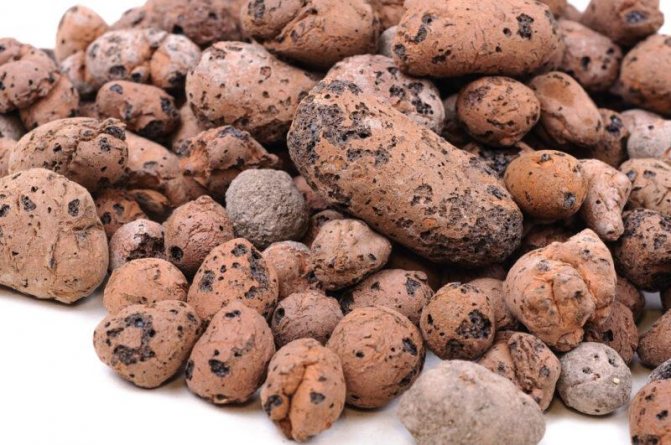
There are the following types (depending on the shape of the fragments):
- Expanded clay gravel. It consists of cellular elements of a streamlined oval shape, their size varies from 5 to 40 mm in diameter. Typically, this type is used when there is a need to create a layer of insulation over 5 centimeters.
- Expanded clay crushed stone. The size of the pieces is approximately similar to expanded clay gravel, but their shape is more like a cube, the edges and corners of which protrude sharply. The technology for its production comes down to crushing larger fragments of expanded clay.
- Expanded clay sand. The particle size ranges from approximately 14 to 50 millimeters. The peculiarity of this type of building material makes it possible to create a layer of thermal insulation less than 5 centimeters thick without losing its insulating qualities. In addition, it is used in the range of 14-50 millimeters. Small dimensions allow the use of expanded clay sand with a heat-insulating layer thickness not exceeding 5 centimeters. It is also used as a filler for concrete or other mortar.
A ten-centimeter layer of such insulation is comparable in its heat-insulating properties to a wooden beam, 25 centimeters thick, a slab of expanded clay concrete, 60 centimeters thick, or a meter of brickwork. When using a layer over 15 centimeters, you can achieve the maximum insulating effect. This type of insulation is also economically beneficial, since the cost of purchasing it will be several times lower compared to other types of insulation. Expanded clay will cost 10 times less than brick, and 3 times more economical than wood.
Advantages of expanded clay
This thermal insulation material is very economical. When using expanded clay, you can sound and heat insulate your home with the least investment of money. The material has a high fire safety rating and a high degree of environmental friendliness, since various types of clay are used for its production. It also has a significant service life. This is due to the fact that the material does not condense moisture.
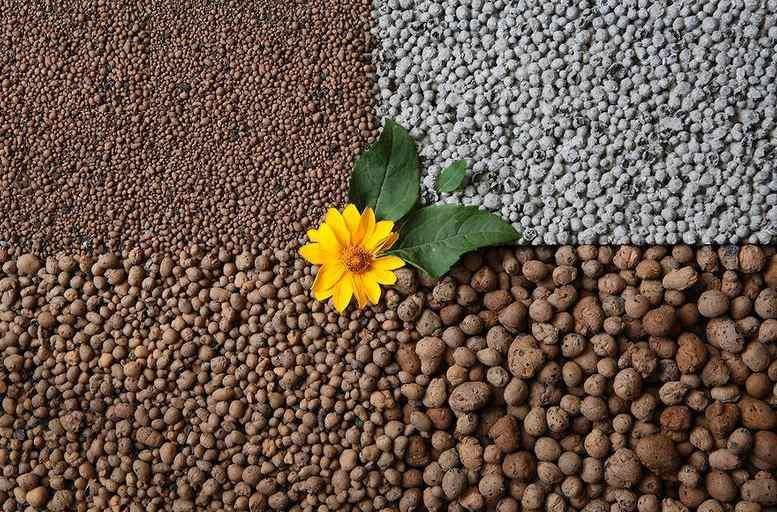
This insulation has a crumbly structure and consists of countless pores, which prevents the appearance of rodents and insects in it. One of the key advantages of expanded clay is its increased resistance to high temperatures. In this regard, the material is suitable for installation in extreme climatic conditions. Using expanded clay, you can achieve a high level of noise insulation, which is a big plus for work on the upper floors of buildings.
Any material used for construction must meet environmental safety requirements. Expanded clay is made exclusively from pure clay, which does not contain various chemical additives. Therefore, it is completely safe for human health. In the production of oval varieties of expanded clay, clay is fired.
Advantages and disadvantages of expanded clay
Compared to widely used slab insulation materials such as mineral wool, expanded clay is much more profitable. When insulating a roof with expanded clay, no special skills or abilities are required. The use of bulk thermal insulation does not require adjustment of elements and additional fastenings . Roof insulation with expanded clay has the following advantages:
- Expanded clay is a highly environmentally friendly material . It does not decompose and does not emit toxic gaseous fumes that are hazardous to human health.
- Not edible for rodents.
- Has increased resistance to frost . Can withstand up to 25 cycles of complete freezing and thawing.
- Fireproof and fireproof material.
- Excellent heat and sound insulator .
- When wooden surfaces are insulated with expanded clay, their service life increases to 50 years.
- Lightweight material.
- Resistant to chemical attack.
- Cheap , a cubic meter of slab insulation will cost several times more than expanded clay of the same volume.
- When using high-quality expanded clay insulation, the thermal conductivity of which is 0.07-0.16 W/m, heat loss is reduced by 70-80% .
clay is a bulk material ; it fills almost the entire provided volume. This, unlike slab insulation, allows for the most effective insulation of small cavities.
Characteristics of expanded clay
Expanded clay is baked clay without chemical impurities. It has a rounded granule shape, a porous structure, and weighs little. It has high levels of noise suppression and thermal insulation. This is an environmentally friendly material, does not decompose and does not contain toxins. It also has increased water resistance and fire safety. In addition, this material is resistant to low temperatures, which is undoubtedly very important in the climatic conditions of our country. With such positive qualities, this insulation has a relatively inexpensive price.
True, it also has one drawback: expanded clay is quite fragile. Therefore, its use requires careful handling. If the granule is damaged, it may lose some of its properties.
Disadvantages of expanded clay insulation
- The lightness of the material is relative . So, when installing thermal insulation, a layer of expanded clay of 10-40 centimeters is required . Even such light-weight porous elements in such a volume will create a significant load on the underlying supporting structures.
- Expanded clay strongly absorbs moisture , which negatively affects its thermal insulation properties. It is imperative to install layers of hydro- and vapor barrier.
- The fragility of the material can lead to mechanical damage to the integrity of the granules. Water will get into unprotected pores and voids, which will lead to the loss of the positive properties of expanded clay.
How to determine the optimal insulation thickness?
In accordance with regulatory documentation, the required thickness of the thermal insulation layer depends on the climatic zone in which the building is built and the area of the insulated room.
The climate zone is determined by special maps; they can be found in SNiP or TKP for heating engineering.
The required insulation thickness depends on the thermal resistance value of the structure being calculated (R) . This is a standard value, depending on the climatic region, as well as on the type of insulated structure.
The values for the floor, walls and ceiling will vary significantly. If you do not know what layer of expanded clay is needed to insulate the roof, then we suggest you use the formula below.
Roof insulation with expanded clay: layer thickness and calculation formula (P):
P=R*k
Where k is the thermal conductivity coefficient of the material. For expanded clay, its value is 0.16 W/m*k.
Types of expanded clay for roof insulation
Builders most often use the following types of expanded clay for roof insulation:
- Crushed expanded stone
granules are quite large in size, not exceeding 4 centimeters in diameter. It is used for insulation of roofs, floors and walls. - Gravel expanded clay
- large granule sizes, reaching 4 centimeters. - Sandy expanded clay
is fine-grained particles up to 5 millimeters in size. It is used to insulate a layer about 5 centimeters thick.
If you don’t have enough money to hire a specialist, you can do this installation yourself. Before you start working, you need to become familiar with the insulation process. There are several stages:
- interior styling,
- installation of vapor barrier,
- installation of insulation,
- surface finishing works.
Alternative types of insulation
Expanded clay is not the only widespread thermal insulation material used in roofing structures. Let's look at the most common options:
- Expanded polystyrene, better known as a type of polystyrene foam. The thermal protection of such material is much better than that of cotton insulation. The layer of polystyrene foam insulation will be much thinner. Polystyrene foam does not absorb water and is quite rigid and durable. The use of specialized additives allows for increased fire resistance. But, if the material does catch fire, toxic gases will be released that are dangerous to human health and life. Unlike expanded clay, mice and rats love to chew foam.
- Basalt wool and mineral wool. The fibrous structure of this type of insulation ensures its high saturation with air. This allows them to be used as a thermal insulation material. When laying fiberglass, you will need additional protection: gloves and a respirator. Disadvantages include susceptibility to rotting, as well as high cost .
- Polyurethane foam. Foam insulation manufactured directly on the construction site. Application is carried out with a special gun. The expansion of the material after application allows you to create a monolithic insulating structure. It is lightweight and fire resistant . The service life is about half a century. The disadvantage is the need to use specialized equipment and an experienced team for high-quality work.
- Ecowool. A material containing 80% cellulose fiber and 20% fire-resistant and antiseptic additives. Has good heat and sound insulation . Ecowool forms a seamless coating that eliminates the formation of cold bridges. Service life - more than 50 years .
Roof insulation with expanded clay: technology and features
Required tools and materials :
- Vapor barrier;
- Waterproofing;
- Rake used for compacting and leveling;
- Shovel;
- Buckets;
- sharp knife;
- expanded clay
Before insulation, some preparatory work should be carried out. They include leveling and cleaning the covered surface, as well as sealing cracks and cracks. You can read more about roof insulation here.
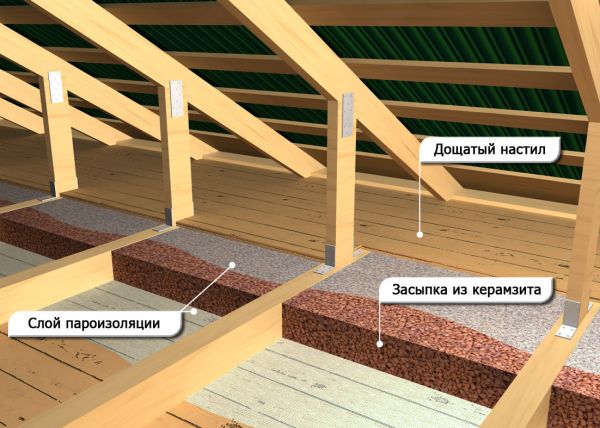
Flat roof roof pie
If laying is done on metal, it should be cleaned of oxidation products and painted with an anti-corrosion compound .
- The first layer on the base is a vapor barrier. You can use both membrane and ordinary polyethylene films. Using a vapor barrier with one foil side will provide an additional effect of heat reflection into the room. Any vapor barrier material is overlapped and also pulled tight. The joints are glued together with specialized tape .
- Expanded clay insulation is carried out in strips. To do this, guide rails are attached to the vapor-insulated base in increments of 2-3 meters. The thickness of the expanded clay layer must correspond to the calculated value . A smaller layer will not provide the necessary thermal insulation, and a thicker one can lead to the destruction of the load-bearing structure being covered.
- After filling the entire area, the expanded clay layer is leveled and compacted .
- A layer of waterproofing is laid on top of the expanded clay or a cement screed is installed, which improves the strength and rigidity of the structure.
- To assess the quality of the thermal insulation work performed, it is necessary to warm the room to a certain temperature, while closing all doors and windows.
- After a couple of hours, check the thermometer readings before and after. If there is a significant drop in temperature, then you need to inspect the insulated surface for gaps and cracks.
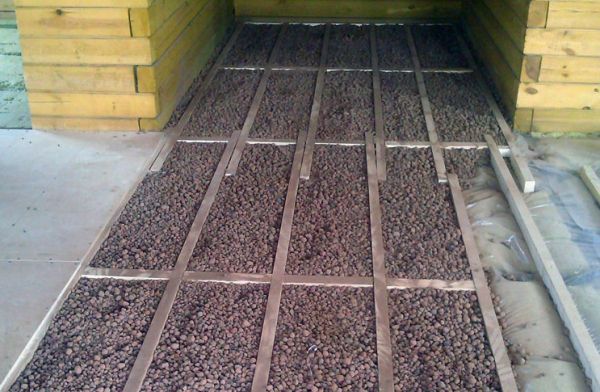
Floor lathing allows you to divide expanded clay into separate cells and serves as joists for the subfloor
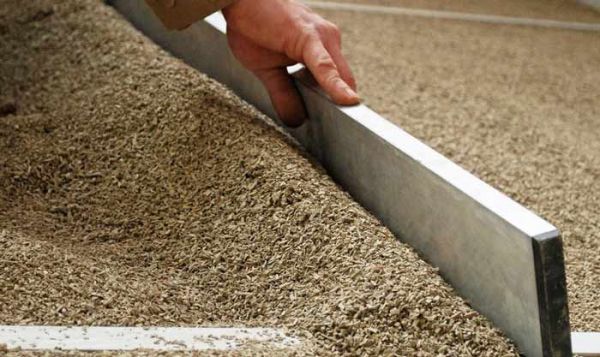
Leveling the expanded clay layer using a building level
